The Philippine lifestyle is deeply rooted in culture, tradition, and community. Explore what makes daily life unique—from strong family values,” lami” cuisine and rich traditions.
When you are here you see the respect for elders and the family-community way of living shape Filipino society.
Key Takeaways
What you will see is family values, respect for elders, and a strong sense of community and cooperation.
Religion plays a significant role in the daily lives of Filipinos, predominantly Roman Catholic, along with a diversity of other beliefs including Islam and indigenous traditions.
Filipino food is both diverse and flavorful, showcasing a variety of regional specialties with communal dining being a central aspect of their food tradions just as eating with your hands called “Kamayan”
1 Embracing Filipino Values
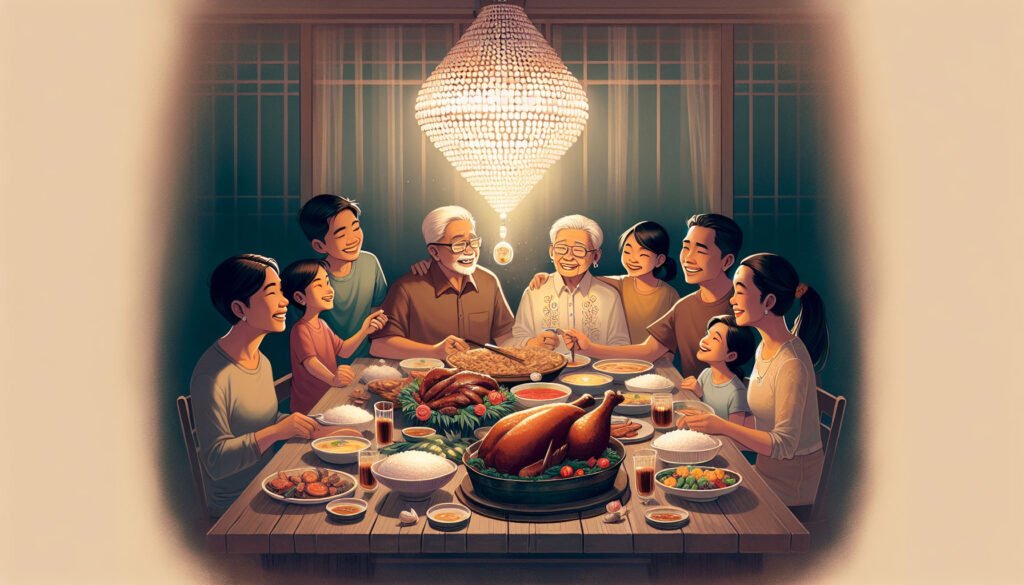
Family is the Top priority for most Filipinos, trumping all other obligations. This family-oriented nature is evident in the way extended families bond and how friends often become part of the family circle.
This connection extends globally with the term ‘Overseas Filipino’ OFW encompassing citizens of Filipino ancestry living abroad, highlighting the far-reaching influence of Filipino culture and the ties that bind them together.
Respect for Elders
Respect for elders is a hallmark of Filipino values, manifesting in everyday interactions and social etiquette.
Simple acts like using honorifics ‘po’ and ‘opo’, the traditional gesture ‘pagmamano’, and addressing older individuals as ‘Ate’ or ‘Kuya’ exemplify the reverence Filipinos hold for their seniors.
This respect also translates to settings such as dining, where it is customary to wait for elders to begin eating before others do. I am older so this was a bit of a different expierence. Love the respect though.
Philippines culture is its values, woven into everyday life and defining the essence of what it means to be Filipino. Relationships and community are the way of Filipinos either on the island or abroad.
Filipino society, with personal attachments systems, kinship, obligation, and religion playing pivotal roles in shaping social behaviors.
Strong Family Ties of Philippine Lifestyle
Filipino society lies the unshakeable foundation of strong family ties. The family structure often extends beyond the immediate circle to include an extended family network that offers support and camaraderie.
As adults, many Filipinos choose to live with their families, maintaining close relationships throughout their lives.
It’s common to see multiple generations living under one roof, sharing responsibilities and celebrating life’s acheivements together.
Community Spirit
The concept of family extends to Filipinos overseas, who carry the essence of these strong bonds across oceans.
Referred to as ‘Overseas Filipinos’, they embody the heart of their homeland, often sending support back to their families and maintaining ties that transcend geographical boundaries.
This global family network is a testament to the enduring power of Filipino kinship.
Community Spirit shows up everywhere. Filipinos come together, embodying the essence of ‘Bayanihan’.
This fosters resilience, enabling communities to thrive in the face of adversity.
The spirit of community, or ‘Pakikisama’, is the glue that binds Filipino society together.
It’s a spirit characterized by cooperation and a willingness to perform good deeds without expecting anything in return, a concept known as ‘Bayanihan’.
Whether it’s helping a neighbor in need or participating in community projects, Filipinos show a communal spirit that emphasizes collective wellbeing over individual gain.
The Role of Religion in Daily Life
Religion is woven into the very fabric of daily life in the Philippines, influencing everything from social norms to festive celebrations. With over 86 percent of the population identifying as Roman Catholic, it is the predominant faith, shaping the moral and spiritual landscape of the country.
The church calendar dictates the rhythm of life, with regular masses, confessions, and religious festivals marking the passage of time and imbuing daily routines with spiritual significance.
Yet, the religious tapestry of the Philippines is rich and diverse. Aside from Catholicism, the archipelago is home to Protestantism, Buddhism, and Islam, the latter introduced around the 1350s.
Indigenous tribal religions also persist, particularly in remote regions, maintaining a spiritual connection to the land and ancestors. This blend of beliefs showcases the religious diversity and cultural richness of the Filipino people.
Roman Catholicism
Catholicism in the Philippines is more than a religion; it’s a way of life that influences social interactions, festivities, and even the landscape with its numerous churches and religious icons.
The church dictates not only spiritual practices but also social gatherings, with religious festivals and holy masses serving as focal points for communal life.
Filipino folk Christianity is unique, blending traditional Catholic practices with native animism, such as the ritual blessing of seeds before planting, showcasing how faith is deeply interwoven with the country’s agrarian roots.
The influence of Roman Catholicism is evident in the country’s history, from the colonial era to the present day.
Religious holidays like Christmas (which starts in September) and Holy Week are celebrated with fervor, with traditions that have been passed down through generations.
The patron saints of towns and cities are honored through vibrant fiestas, reflecting the enduring Spanish influence on Filipino culture.
Other Religions
Islam holds a significant place in the religious landscape of the Philippines, particularly in the southern regions of Mindanao, Sulu, and Palawan, where about 6% of the population practices the faith.
The cultural heritage of Muslim Filipinos is richly displayed through arts such as the singkil dance, which is recognized as an Intangible Cultural Heritage.
Indigenous folk religions, followed by around 2% of the population, continue to thrive through oral traditions and rituals that honor figures like the Tagalog’s Bathala and Maranao’s Sarimanok.
The presence of these various ethnic groups and their respective religious beliefs adds to the cultural diversity of the Philippines.
Each faith contributes its own customs, festivals, and practices, enriching the country’s tapestry and highlighting the respect for religious pluralism within Filipino society.
Filipino Cuisine: A Culinary Journey
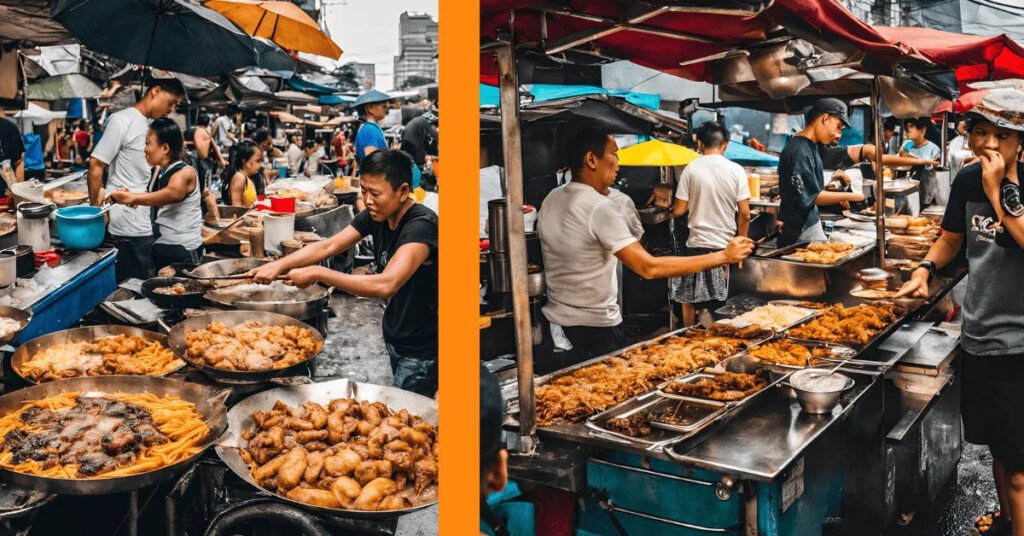
Filipino cuisine is a gastronomic journey that mirrors the country’s history and natural bounty.
YUMMY>>>>>>>>>
A melting pot of indigenous, Chinese, Spanish, and American influences, Filipino dishes are a testament to the archipelago’s diverse cultural exchanges. Ingredients such as:
rice
coconut milk
fresh fruits
vegetables
are staples, with each region offering its own specialty.
The Filipino diet places an emphasis on fresh, whole ingredients, creating balanced meals that are both nourishing and flavorful.
Filipinos love their food, and this passion is evident in the variety of dishes that grace their tables. From the vinegary tang of adobo to the sour zest of sinigang, and the succulent lechón, the range of flavors is as vast as the archipelago itself.
Street food and local markets are bustling scenes where one can taste the culinary delights that define the local culture, such as the addictive chicharon and the refreshing halo-halo.
Staple Dishes
Rice, the foundation of the Filipino diet, accompanies an array of dishes that showcase the best of Filipino cuisine. Some examples include:
Adobo: a meat stew cooked in a savory mix of vinegar, soy sauce, and spices
Sinigang: a sour soup base
Lechón: PORK a dish with crispy skin
Kare-kare: a dish with a rich peanut sauce
Pandesal: a humble bread roll that can be stuffed with adobo, creating a fusion of traditional and modern flavors.
These dishes highlight the variety and complexity of Filipino cuisine.
Each region boasts its own specialty, from the fish sauce-infused dishes of the northern Luzon to the spicy offerings of the southern islands.
The diversity of Filipino food is a reflection of the Islands varied geography and the cultural influences that have shaped its food scene.
No matter where you are in the Philippines, good food with a local touch is never far away.
Dining Customs
Filipino dining customs are a reflection of the communal nature of the local culture.
Meals are typically served family-style, with a variety of dishes placed at the center of the table for everyone to share. This practice fosters a sense of community and togetherness, making mealtime a social event rather than just a daily necessity.
The ‘Boodle fight’ takes this communal dining experience to another level, with food spread on banana leaves and eaten with bare hands in a symbolic act of camaraderie and equality.
The use of hands, or ‘kamayan’, for eating, especially grilled fish or seafood, is a beloved tradition that connects Filipinos to their ancestral practices.
While spoons and forks are commonly used, the act of eating with hands remains a cherished custom that speaks volumes about the Filipino’s connection to their food – a connection that’s both primal and intimate.
Street Food and Local Markets
Local markets, meanwhile, are a feast for the senses. These bustling hubs offer fresh produce, seafood, and meat, allowing one to witness the daily life of Filipinos as they haggle and socialize.
Wet market is the meats and fish. Dry market is all the rest.
Also check out the Night markets where the food and festival vibe is. Street food scene in the Philippines is as vibrant and diverse
The markets are where the heart of the Filipino food scene beats the loudest, with the country’s rich biodiversity shining through in the variety of native ingredients like kalamansi and pili nuts that enhance the local dishes.
Hawkers peddle an array of deep-fried delights like chicharon and squid balls, as well as the smoky flavors of ‘inihaw’, or barbecued meats.
These street-side offerings provide a glimpse into the everyday culinary habits and preferences of local Filipinos, making street food a cultural experience in itself.
Arts and Culture in the Philippines
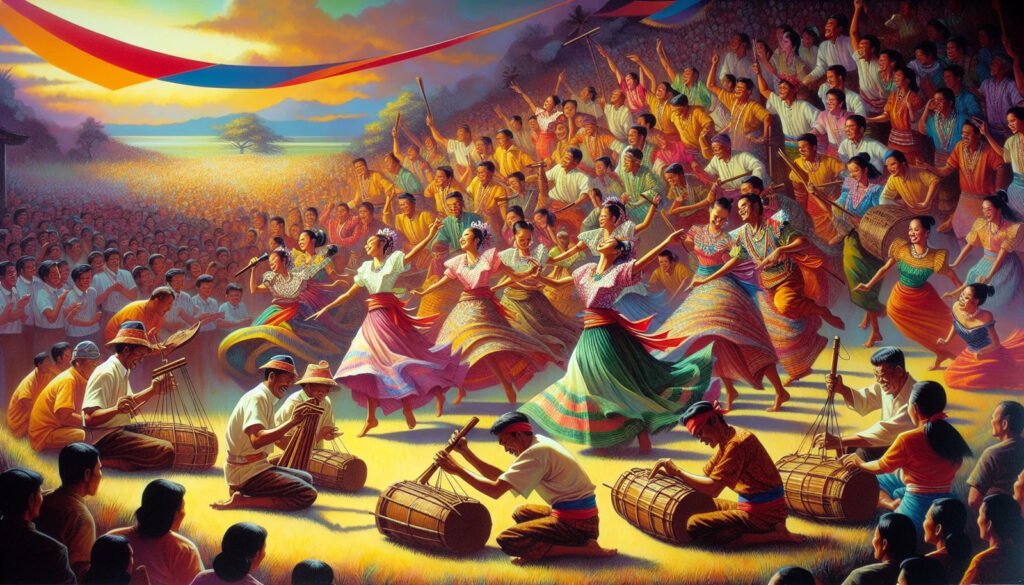
The arts and culture of the Philippines are as colorful and dynamic as its landscapes. Rooted in a mix of native traditions and external influences, Philippine art is a canvas upon which the history and aspirations of its people are painted.
The National Commission for Culture and the Arts classifies Filipino arts into traditional and non-traditional forms, encompassing everything from:
weaving
carving
folk literature
performing arts
Filipinos love to express themselves through a variety of artistic mediums. From the protest art that has played a role in shaping the national consciousness to the innovative designs in architecture, Filipinos have a penchant for creativity and originality. This creativity extends to:
the vibrant festivals and celebrations that dot the cultural landscape
each one a reflection of the Philippines’ diverse heritage
the community spirit that binds its people together.
Visual Arts
The visual arts in the Philippines have a rich and storied past, stretching back to the earliest forms of expression found in the Angono Petroglyphs. Some of the key art forms in the Philippines include:
These art forms are a testament to the pre-colonial artistic heritage that continues to thrive today and have shaped the visual arts landscape of the country.
Weaving, an ancient art form with distinct techniques among different ethnic groups
Woodcarving, with its intricate bululs figures
European painting techniques introduced during the Spanish period, which gave rise to a new era of Filipino painters
Filipino visual arts have evolved over the centuries, often reflecting the socio-political climate of the times.
From the traditional to the contemporary, Filipino painters and artists have consistently used their craft to communicate nationalistic themes and cultural diversity, contributing to the country’s rich artistic heritage.
Music and Dance
Music and dance are the pulsating heart of Filipino culture. These art forms are an amalgamation of the country’s history, from the rhythmic dances of indigenous peoples to the Spanish-influenced choreographies.
Traditional dances like Tinikling and Singkil tell stories through movement, while the wide variety of Filipino music genres, from folk to rock and hip hop, showcase the adaptability and creativity of Filipino musicians.
Filipino culture known for musical instruments and the social harmony they bring to gatherings and celebrations.
Many Filipino musicians have gained acclaim, highlighting the country’s love for music and its ability to unite people across cultural divides.
Music and dance a big part to Filipino society. Think Karaoke….ALOT.
Festivals and Celebrations
Filipino culture is its celebration of Christmas, lasting from September to December, making it one of the longest Christmas celebrations in the world.
These festivals not only serve as a platform for showcasing the local culture and food scene but also reinforce the community spirit, social harmony, and nationalistic themes that are central to Filipino society.
The Philippines’ festivals are a vibrant expression of its cultural diversity and history.
Each festival, whether religious or cultural, is a kaleidoscope of colors, sounds, and emotions, inviting participation and celebration.
The MassKara Festival, with its colorful masks and street dances, and the Moriones Festival, reenacting the story of Longinus.
Education and Language
Education in the Philippines is a mirror reflecting the country’s commitment to growth and development.
The educational system is managed by different government agencies, each focusing on various aspects of learning from primary to higher education. The system includes:
Kindergarten
Elementary school
Junior high school
Senior high school
Compulsory at the basic education level, this system ensures a broad and inclusive foundation for Filipino youth.
Public and Private Schools
Language plays a significant role in shaping the Filipino identity, with Filipino as the national language and English as an official language of instruction and commerce.
The archipelago is a tower of Babel, with over 135 indigenous languages spoken across the islands.
The landscape of Philippine education is marked by a blend of public and private institutions.
Public schools, funded by the national government, bear the legacy of American colonial influence, while private schools have the autonomy to craft curricula that may include specialized programs or international standards.
The distinction between the two is often marked by differences in resources, teaching methods, and educational outcomes.
Despite these differences, both public and private schools share the common goal of educating the Filipino youth. Education is not just a path to personal advancement but is seen as a vehicle for social development and nation-building. This dual system of education allows for a range of choices for families and contributes to the diverse educational landscape of the Philippines.
National and Local Languages
Filipino, the national language, is a linguistic symbol of unity in a country with more than a hundred ethnolinguistic groups.
Filipino is based on Tagalog, the predominant dialect of the capital region, and is used in official communication and media across the islands.
English, with its prestige as a language of commerce and the legacy of the colonial era, complements Filipino as a second official language, used extensively in education and business.
The Philippines’ linguistic landscape is further enriched by a multitude of local languages and dialects, with Cebuano, Ilocano, and Hiligaynon among the most widely spoken.
The presence of indigenous groups like the Lumad in Mindanao adds to the richness of this linguistic mosaic.
The country’s commitment to preserving its cultural diversity is reflected in the respect and recognition given to these local languages, ensuring that the voices of all Filipinos are heard and valued in their local language.
Everyday Life and Social Etiquette
Everyday life in the Philippines is steeped in a unique blend of eastern traditions and western modernity. Filipinos are known for their friendliness and hospitality, reflected in their everyday interactions and social customs. Some key aspects of Filipino culture include:
Modesty in dress and demeanor is valued
‘Hiya’ or shame is a guiding principle that influences behavior
The concept of ‘hiya’ is deeply rooted in the Filipino psyche, guiding interactions and ensuring that one maintains a sense of propriety and respect in all situations.
Social etiquette in the Philippines includes:
Avoiding sensitive topics like politics and religion
Giving directions with the pointing of your lips…hmmmm
Using polite gestures instead of direct finger pointing
Emphasizing harmony and good relations within the community
Demonstrating approachability and the spirit of ‘bayanihan’, or community cooperation
Whether in urban or rural settings, Filipinos are known for their warmth and geniality in social interactions.
Dress Code and Appearance
In the Philippines, dress code and appearance often reflect the tropical climate and the cultural emphasis on modesty. Here are some key points to note:
Light, breathable clothing made from fabrics like cotton is the norm for everyday wear, suiting the humid weather.
In urban areas, where cosmopolitan influences are stronger, fashion trends often mirror global styles.
In rural areas, clothing tends to be more traditional and practical, reflecting the lifestyle and environment.
Formal attire in the Philippines is a nod to the country’s history and cultural pride.
Men don the Barong Tagalog, an embroidered shirt, and women may wear the Filipiniana dress for special occasions.
These pieces of clothing are not just garments; they are expressions of Filipino heritage and craftsmanship, proudly worn to celebrate the nation’s identity and traditions.
Socializing and Hospitality
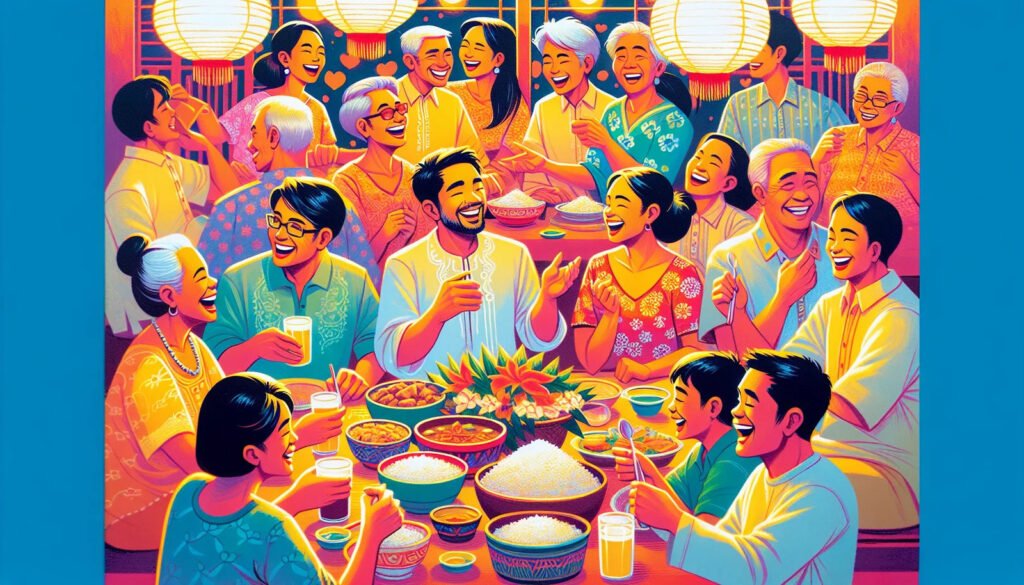
Hospitality is second nature to Filipinos, with the word ‘Mabuhay’ symbolizing their warm welcome and inclusive spirit.
Visiting a Filipino home often entails a display of genuine hospitality, with guests frequently offered refreshments or a meal regardless of the time of day.
The act of bringing ‘pasalubong’, or small gifts, is a common courtesy that reflects the value placed on gratitude and reciprocity in Filipino society.
The concept of hospitality extends to the dining table, where it is customary to appreciate the host’s efforts by complimenting the food. In many Filipino homes, guests may also be expected to observe local customs, such as removing their shoes before entering.
This level of hospitality not only makes guests feel welcomed but also strengthens the bonds of friendship and community within Filipino society.
Navigating Urban Life
Urban life in the Philippines is a tapestry of contrasts, where the hustle and bustle of the city meets the laid-back rhythm of island life.
The greater Manila area, in particular, is known for its:
Traffic and pollution challenges
Resourcefulness of its residents in navigating these obstacles
Ubiquitous public transportation options like jeepneys and tricycles, providing an affordable means of getting around
Ride-hailing apps like Grab, offering convenience amid the chaos.
Shopping malls serve as modern-day plazas in urban areas, not just for shopping but also as recreational venues where families and friends gather.
These malls are a testament to the Filipinos’ ability to adapt to and integrate modern conveniences into their daily lives.
Despite the rapid urbanization, the sense of community remains strong, with local markets and neighborhood gatherings maintaining the traditional fabric of Filipino life.
Sports and Recreation
Sports and recreation are integral parts of Filipino life, reflecting the nation’s love for competition and community gatherings.
Basketball holds a special place in the hearts of many Filipinos. Amateur games are a common sight in neighborhoods, where makeshift hoops rise from every corner.
The sport is more than just a pastime; it’s a source of national pride, with the Philippines fielding strong contenders in international competitions.
Traditional games and martial arts also play a significant role in Filipino recreation, serving as a link to the country’s cultural heritage.
Games like luksong baka, patintero, and sungka are cherished childhood pastimes, while martial arts such as Arnis, the national sport, are practiced both as an art form and a means of self-defense.
These activities not only promote physical fitness but also foster a sense of national identity and cultural pride.
Basketball and Boxing
In the Philippines, basketball and boxing are not just sports; they are national obsessions. The basketball court is the country’s unofficial town hall, where communities come together to play, cheer, and celebrate. The national basketball teams have a history of success, often punching above their weight in international championships, fostering a sense of unity and national pride.
Boxing, on the other hand, has produced some of the country’s most revered sports icons.
Filipino boxers are known for their skill and tenacity, earning accolades in regional and international arenas.
The sport has become synonymous with the Filipino fighting spirit, exemplified by champions who have risen from humble beginnings to achieve global fame.
Traditional Games and Martial Arts

Traditional Filipino games are a window into the country’s playful spirit and communal values.
Sungka, a board game played with shells, and luksong tinik, a jumping game, are just a few examples of games that have been passed down through generations.
These games are more than mere entertainment; they are cultural artifacts that preserve the simplicity and joy of traditional Filipino childhoods.
Martial arts, particularly Eskrima or Arnis, are not only a form of self-defense but also a cultural treasure.
These arts, which have seen a resurgence in popularity, are steeped in history and are as much a part of Filipino identity as the country’s language and cuisine.
Practicing these martial arts is a way for Filipinos to connect with their heritage and showcase their nationalistic pride.
Modern Entertainment
Modern entertainment in the Philippines is a blend of traditional cultural displays and contemporary leisure activities.
The film industry is vibrant, producing movies that resonate with local audiences and often gain international attention.
Cultural shows that feature traditional dances and music are popular, providing a platform for artists to showcase their talents and for audiences to experience the richness of Filipino performing arts.
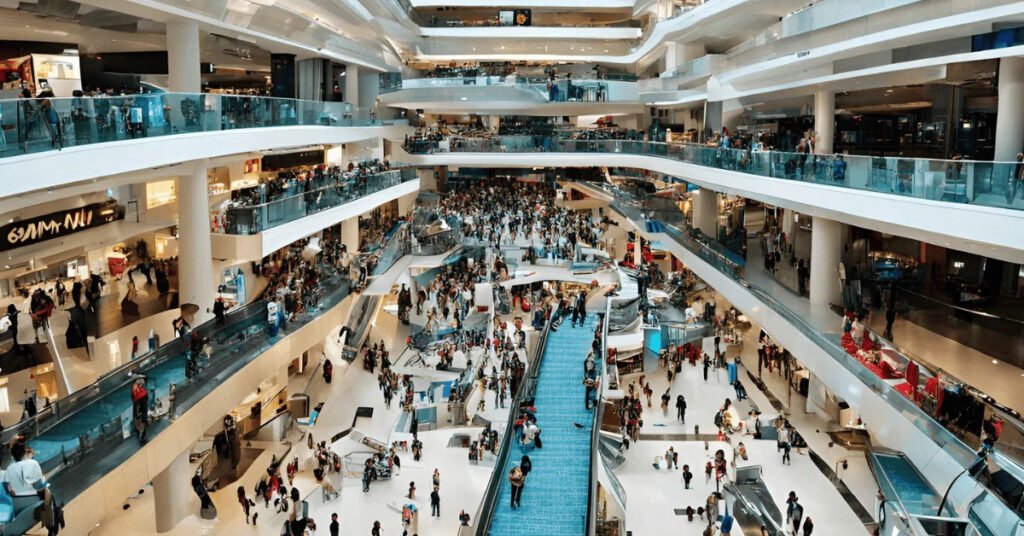
Shopping malls are more than just commercial centers; they are the social hubs of city life, where Filipinos gather for a variety of entertainment options from cinemas to food courts.
These malls are a testament to the American influences in the country and a reflection of how Filipinos have made these spaces their own, incorporating them into their daily life and social fabric.
Health and Wellness
Health and wellness in the Philippines are influenced by a mix of traditional practices and modern healthcare approaches.
Traditional herbal medicine is widely used across the country, treating digestive and respiratory issues with natural remedies passed down through generations.
Hilot, the traditional Filipino massage, is an integral part of wellness practices, revered for its healing and therapeutic benefits.
The modern healthcare landscape in the Philippines is a combination of public and private institutions.
Public hospitals focus on preventive care, while private hospitals offer specialized treatments for a range of conditions
The Universal Health Care law is a significant step towards ensuring that all Filipinos have access to medical services, reflecting the country’s commitment to the health and well-being of its citizens.
Traditional Medicine
Traditional medicine in the Philippines, known as ethnomedicine, is an ancient art that remains an important part of the country’s healthcare system.
Utilizing a wide array of herbal remedies and spiritual healing techniques, traditional medicine practitioners offer holistic approaches to health that complement modern medical practices.
This integration of old and new embodies the Filipino respect for heritage and the adaptability to embrace innovation.
The use of ethnomedicine reflects the Filipino’s deep connection to nature and a belief in the healing powers of the environment.
These practices are not only about treating ailments but also about maintaining balance and harmony within the body and mind.
In a country with diverse flora and fauna, traditional medicine continues to be a rich source of wellness and therapeutic knowledge.
Modern Healthcare
The modern healthcare system in the Philippines is a testament to the country’s efforts to provide comprehensive medical care to its citizens. The key features of the healthcare system include:
The public and private sectors working together to address the health needs of the population
Programs like PhilHealth offering benefits packages that cover a range of medical services
Challenges such as reliance on imported medical devices being addressed to ensure quality care for Filipinos
The Philippines is also emerging as a destination for medical tourism, offering a combination of skilled healthcare professionals and affordable medical procedures.
This growing sector is a reflection of the Filipinos’ commitment to health and wellness and their ability to provide services that attract visitors from around the world.
The focus on healthcare is not just about treating illnesses but also about promoting a holistic approach to well-being, aligning with the Filipino value of taking care of one another.
Travel and Tourism
Travel and tourism in the Philippines offer an escape into a world of natural wonders and cultural richness. Some of the top destinations include:
El Nido: Known for its limestone cliffs and white-sand beaches
Boracay: Famous for its beautiful beaches and vibrant nightlife
The Chocolate Hills of Bohol: A unique geological formation of over 1,000 hills
Cebu: Home to historical sites and vibrant city life
These destinations make the Philippines a treasure trove for adventurers and history buffs alike, showcasing the rich cultural heritage of Southeast Asia.
Travelers to the Philippines should be prepared for the unexpected, from the logistical challenges of island-hopping to the simple realities of rural life, such as the lack of ATMs.
Yet, these experiences are part of the charm, offering a glimpse into the Filipino way of life that is both resilient and joyful.
Whether exploring the bustling streets of Manila or the serene waters of Palawan, the Philippines promises an unforgettable journey.
Natural Wonders
The Philippines is a haven for nature lovers, with natural wonders that range from:
the underwater marvels of Tubbataha Reefs
the symmetrical slopes of Mayon Volcano
El Nido’s stunning beaches
Kawasan Falls’ refreshing lagoons
These sites offer not only breathtaking views but also opportunities for outdoor activities such as diving, trekking, and windsurfing.
The country’s commitment to preserving its natural beauty is evident in the numerous protected areas and conservation efforts.
The Philippines’ rich biodiversity is a national treasure, providing fresh air, a sweet tooth for adventure, and a respite from the hustle of modern life.
Exploring these natural wonders is an experience that feeds the soul and ignites a deep appreciation for the Earth’s gifts.
Cultural Sites
The cultural heritage of the Philippines is proudly displayed in its historical landmarks and architectural marvels.
Intramuros, the walled city of Manila, tells the story of the country’s colonial past, while the Baroque Churches of the Philippines stand as monuments to the enduring Spanish influence.
These sites are not just tourist attractions; they are chapters of the Filipino narrative, offering insights into the country’s tumultuous history and the resilience of its people.
Beyond the historical structures, the Philippines celebrates its culture through the preservation of heritage towns like Vigan and the honoring of national heroes such as Dr. Jose Rizal.
The architecture of the islands, from churches to government buildings, is a fusion of indigenous and colonial styles, each structure a canvas reflecting the country’s cultural diversity and rich history.
Visiting these cultural sites provides an immersive experience into the soul of the Philippines, where the past meets the present in a continuous dance of identity and evolution.
Summary
The Philippine archipelago is a land of contrasts and confluences, where ancient traditions meet modern sensibilities, and the warmth of its people shines as brightly as its tropical sun.
From the strong family ties that bind its society to the vibrant festivals that paint its streets, the Philippines offers a rich cultural experience.
Its cuisine, arts, and natural wonders are a testament to the country’s diverse heritage and resilient spirit.
As this journey through the Filipino lifestyle concludes, it becomes clear that the Philippines is more than just a destination; it’s a celebration of life in all its forms.
Whether through the savory delights of its cuisine, the harmonious melodies of its music, or the serene beauty of its islands, the Philippines invites you to discover, experience, and embrace its unique tapestry of life.

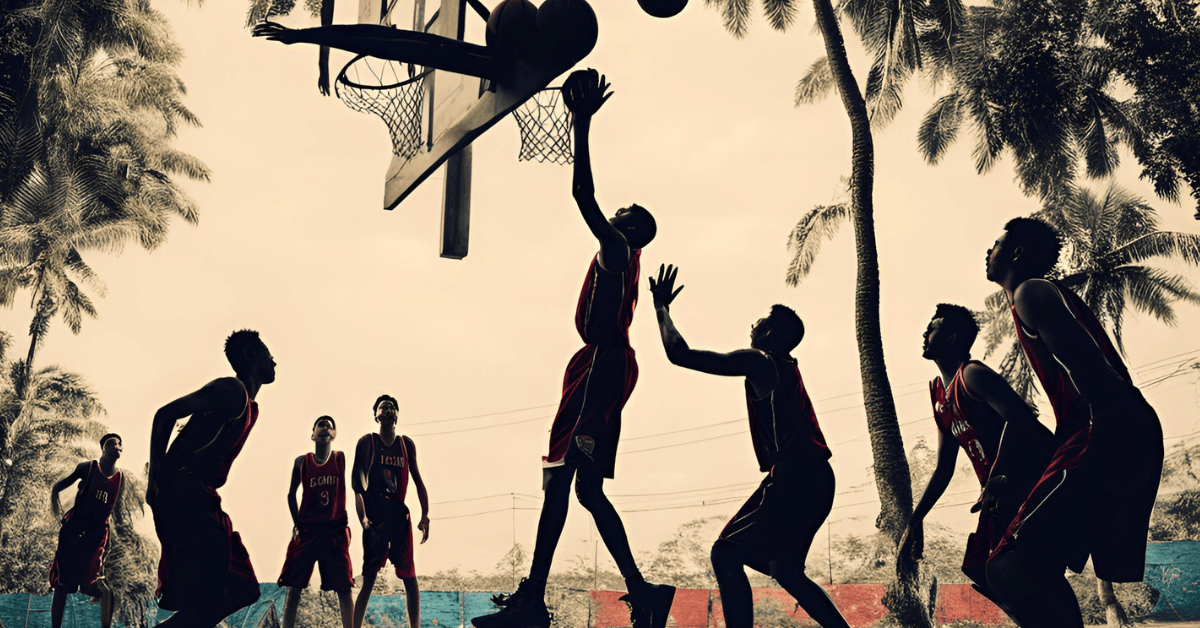

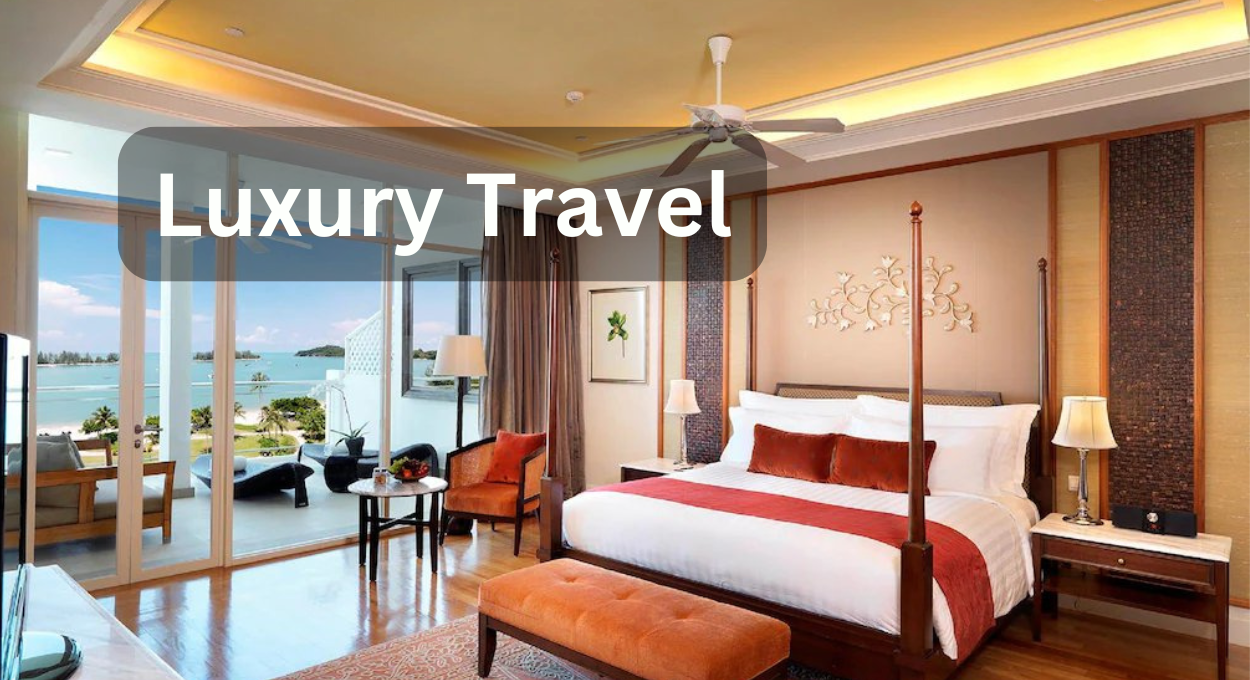
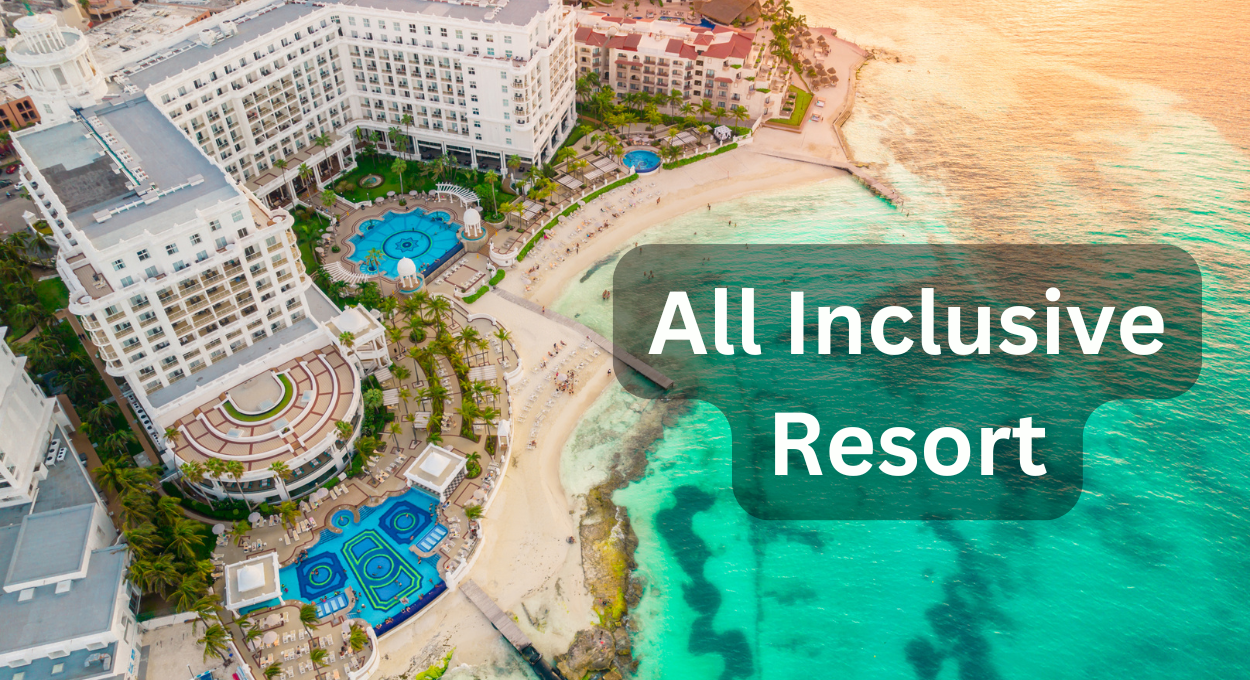



2 thoughts on “Discovering the Rich Philippine Lifestyle: Traditions, Food, and Daily Life”